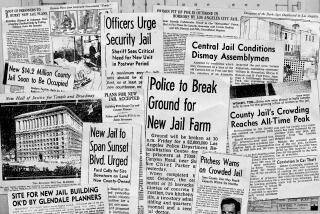Seized Weapons Show Need for Security Devices
- Share via
One recent morning, an ex-con harboring a grudge and hiding a 14-inch butcher knife swaggered through the door of Orange County’s Central Justice Center.
The blade was tucked behind his shirt and deep inside his waistband. It set off an alarm as he passed through one of the courthouse’s five metal detectors.
The ex-con remained silent as a security guard waved a magnetic wand up and down his jeans, peppering him with questions about whether he was wearing a brace, or perhaps had a prosthetic leg.
“Oh this,” he finally said as he drew the knife from its hiding place and pointed it toward the ceiling, security officials said.
Two years ago, before the Justice Center became one of the last urban courthouses in the state to install airport-style metal detectors, he would have been able to walk the halls and even into courtrooms undetected. Instead, he was ordered to drop the weapon, and was then handcuffed and taken into custody.
Safety advocates say such incidents illustrate how important X-ray machines and other forms of weapon screening can be in courthouses as well as airports--and underscore the glaring need for more safeguards.
A state task force that studied the issue for three years released a report this year urging the state to improve security at courthouses. In response, the state’s new budget allocates $22.5 million for surveillance equipment and extra security staffing.
The study found that more than 30 courthouses in Southern California need tougher security. The budget sets aside nearly $3 million for Los Angeles County and more than $2 million for Orange County.
“We’re very concerned about the increase in court violence in California courts,” said Lynn Holton, spokeswoman for the California Judicial Council.
At Orange County’s main Superior Court building in Santa Ana, 12,410 items, ranging from the downright deadly to the simply bizarre, have been intercepted since security gates were installed in late 1999.
The inventory through June included 4,715 knives, 1,638 razor blades, an assortment of drugs, pipes and other drug paraphernalia, and a lone firearm. Twelve arrests have been made on a variety of charges, most of them involving possession of illegal weapons or narcotics.
“It’s really kind of scary how many weapons we’ve recovered,” said Guy Smith, a special officer with the Orange County Sheriff’s Department who regularly patrols the courthouse entrances.
The Sheriff’s Department has also turned up many other items of concern, including tools (1,644), scissors (1,110), corkscrews (1,040), pepper spray (489), letter openers (58) and handcuffs (28).
Guards report similar findings at the Los Angeles Superior Courthouse in downtown Los Angeles, which also got its weapons screening system about two years ago.
Lt. Ron Melton of the Los Angeles County Sheriff’s Department estimated that about 125 items--knives being the most common--are collected each day from the 10,000 people who pass through the detectors. Among the more bizarre seizures at the civil courthouse have been Chinese throwing stars, a World War II Nazi dagger, a leather riding crop and a walking cane with an 18-inch blade hidden in its shaft.
The elderly woman carrying the cane was not arrested, but her walking stick was replaced with a harmless one that the guards had on hand.
In her case and many others, the court-goers do not mean harm. Instead, they are unaware that they are not allowed to carry anything into the courthouse that might be used as a weapon.
“Ninety-nine percent of it is innocent,” said Deputy Robert W. Jaeger, a supervisor at the Criminal Courts Building in downtown Los Angeles.
For training purposes, supervisors keep some of the cleverest weapons recovered, including belts with daggers hidden in the buckle, brushes with ice picks hidden behind the bristles and knives shaped like credit cards.
In Orange County, Sgt. Rudy Mena holds up one of the oddest items in his training collection: a medical intravenous bag found on a woman who had just been released from a hospital. It was confiscated because it presented a biohazard.
“Pretty disgusting, isn’t it?” Mena asks as he displays a zip-lock bag with the IV inside. “I don’t even ask why people carry the things they do. Perhaps she’s one of those people who like to keep everything.”
Gatekeeper Smith and other Orange County special officers--public employees who earn $28,224 to $53,724 a year--must take a 10-week course in reading X-ray monitors and standing watch over metal detectors.
Many have developed such a sharp eye that they can discern from a shadowy outline on a computer screen whether they are dealing with a butterfly knife or a box of Altoids.
Invasion of privacy is one of the most common complaints the courts receive about the new system. Delays are another. Lines of more than 200 people can back up to the street at the main entrance, especially during a busy morning crush.
Orange County housing attorney Richard Spix said he is one of the slowpokes, routinely arriving with box loads of files, shoes that happen to contain metal shanks in the soles, cigarettes with foil packaging, a watch, loose change and more.
“A lot of times I just let other people go because I have so much to unpack,” he said.
Still, surveys by Orange County court employees of lawyers, judges and visitors found that most are willing to accept the inconveniences in exchange for a safer environment.
“It brings a lot of comfort,” said the Santa Ana court’s presiding judge, C. Robert Jameson. “Because if you look back on the number of kooks I’ve dealt with over the years, this is an area of real concern.”
More to Read
Sign up for Essential California
The most important California stories and recommendations in your inbox every morning.
You may occasionally receive promotional content from the Los Angeles Times.










